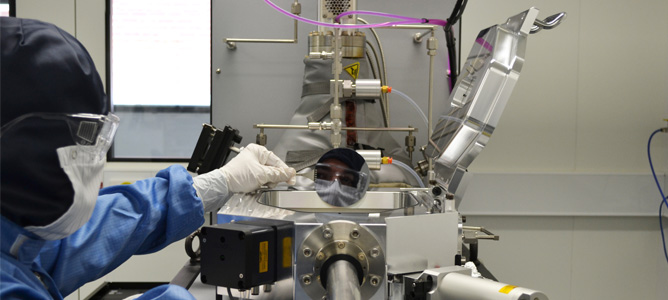NASA connects to MCN for carbon nanotube growth

MCN’s Lachlan Hyde working at the ALD Fiji F200 which was used for the NASA ALD growths.
July 2013
Coatings of nanotube forests developed by NASA are the blackest materials ever measured, which has great importance for many scientific processes. The NASA team has worked for several years to make their formulation black over a wide spectral range and to improve the robustness and the number of materials to which the nanotubes can be applied. With assistance from MCN NASA is further developing carbon nanotube technology for use on parts with complex shapes.
Principal Investigator John Hagopian and co-investigator Vivek Dwivedi of the NASA Goddard Space Flight Center are using Atomic Layer Deposition (ALD) to deposit layered thin-films suitable for carbon nanotube growth on intricate parts.
To gain the highest sensitivity and consistent measurements, carbon nanotubes must be evenly deposited across the surface of the detection component. This requires a highly uniform foundation layer, commonly a film of nanoparticles or iron oxide, to support growth of the carbon nanotubes. This is difficult to achieve using deposition techniques such as sputtering or evaporation because corners and crevasses are left uncoated and there is a large variation in the thickness of the coating. ALD is one technique that can coat all surfaces of an intricate object in a highly controlled and uniform layer.
The NASA researchers worked with MCN’s operating expert in ALD, Dr. Lachlan Hyde to perform a number of iterations for ALD growth of iron thin films. Dr. Hyde used MCN’s spectroscopic variable angle ellipsometer for characterisation, allowing the film thickness and uniformity to be optimised on test wafers.
MCN provided the NASA team with development samples and a detailed report on the process, including development recipes and analysis of ALD film growth. Hagopian and Dwivedi have since conducted trial production of carbon nanotubes on these wafers at NASA.
“We have successfully performed growth on two development samples with an ALD iron catalyst from MCN and the nanotubes have properties very similar to those grown using electron beam deposited catalysts,” Hagopian said.
“Both their ALD process development and characterisation capabilities are world-class. We intend to continue our collaboration and look for additional opportunities to leverage their capabilities to increase our speed of technology development.”


